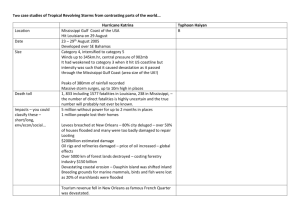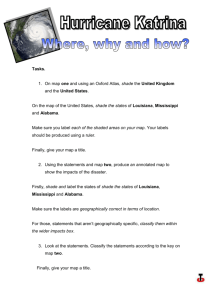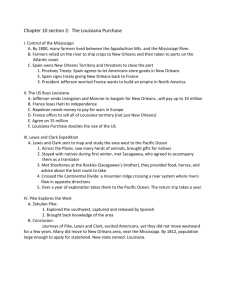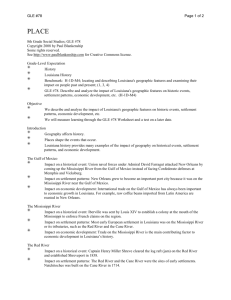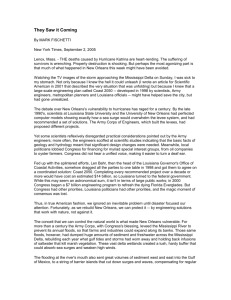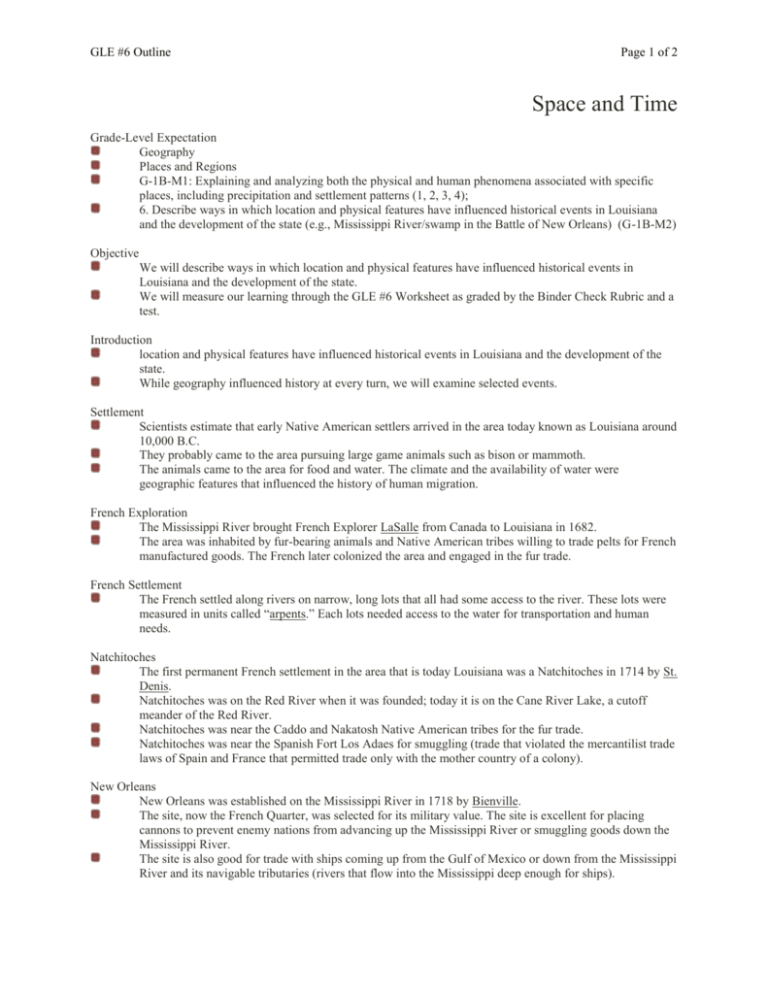
GLE #6 Outline
Page 1 of 2
Space and Time
Grade-Level Expectation
Geography
Places and Regions
G-1B-M1: Explaining and analyzing both the physical and human phenomena associated with specific
places, including precipitation and settlement patterns (1, 2, 3, 4);
6. Describe ways in which location and physical features have influenced historical events in Louisiana
and the development of the state (e.g., Mississippi River/swamp in the Battle of New Orleans) (G-1B-M2)
Objective
We will describe ways in which location and physical features have influenced historical events in
Louisiana and the development of the state.
We will measure our learning through the GLE #6 Worksheet as graded by the Binder Check Rubric and a
test.
Introduction
location and physical features have influenced historical events in Louisiana and the development of the
state.
While geography influenced history at every turn, we will examine selected events.
Settlement
Scientists estimate that early Native American settlers arrived in the area today known as Louisiana around
10,000 B.C.
They probably came to the area pursuing large game animals such as bison or mammoth.
The animals came to the area for food and water. The climate and the availability of water were
geographic features that influenced the history of human migration.
French Exploration
The Mississippi River brought French Explorer LaSalle from Canada to Louisiana in 1682.
The area was inhabited by fur-bearing animals and Native American tribes willing to trade pelts for French
manufactured goods. The French later colonized the area and engaged in the fur trade.
French Settlement
The French settled along rivers on narrow, long lots that all had some access to the river. These lots were
measured in units called “arpents.” Each lots needed access to the water for transportation and human
needs.
Natchitoches
The first permanent French settlement in the area that is today Louisiana was a Natchitoches in 1714 by St.
Denis.
Natchitoches was on the Red River when it was founded; today it is on the Cane River Lake, a cutoff
meander of the Red River.
Natchitoches was near the Caddo and Nakatosh Native American tribes for the fur trade.
Natchitoches was near the Spanish Fort Los Adaes for smuggling (trade that violated the mercantilist trade
laws of Spain and France that permitted trade only with the mother country of a colony).
New Orleans
New Orleans was established on the Mississippi River in 1718 by Bienville.
The site, now the French Quarter, was selected for its military value. The site is excellent for placing
cannons to prevent enemy nations from advancing up the Mississippi River or smuggling goods down the
Mississippi River.
The site is also good for trade with ships coming up from the Gulf of Mexico or down from the Mississippi
River and its navigable tributaries (rivers that flow into the Mississippi deep enough for ships).
GLE #6 Outline
Page 2 of 2
Louisiana Purchase
The United States, under the leadership of President Thomas Jefferson, bought Louisiana from France,
under Napoleon, in 1803.
The United States needed access to New Orleans to move agricultural goods from the Ohio Valley to the
Gulf of Mexico.
The same geographic benefits that caused the French to found New Orleans made the United States willing
to purchase it.
Battle of New Orleans
The British attacked New Orleans in January 1815. The battle was fought outside the city in the area that is
today Chalmette, Louisiana.
The British artillery and infantry bogged down in the muddy earth, giving the Americans, entrenched
behind earthworks, more time to use their rifles to pick off British soldiers.
After the British General Pakenham was killed his former second-in-command called off the attack.
The Capture of New Orleans
New Orleans was captured and occupied by Union forces during the Civil War in April 1862.
Confederate leaders had prepared for the Union Navy to move South along the Mississippi and had
concentrated Confederate Forces at Memphis and Vicksburg, a serious strategic blunder.
Admiral David Farragut brought his ships through the Gulf of Mexico, easily capturing New Orleans as
the small Confederate force guarding the city fled by rail.
Red River Campaign
Union commanders wanted to capture cotton and take the Confederate capital of Louisiana and Texas:
Shreveport.
The Confederate forces made stands near Mansfield and Pleasant Hill in DeSoto Parish to stop the Union
invasion.
The rough terrain in the area caused some cavalrymen to dismount and fight on foot.
The hilly land gave cover to snipers and high ground for artillery.
Soldiers ran into a ravine to find shelter from enemy fire.
Conclusion
Events are shaped by the places where they occur.
As we continue to learn about Louisiana history we will see more examples of the impact of geography on
history.
Copyright 2008 by Paul Blankenship. Some rights reserved. Creative Commons Attribution-Noncommercial-Share Alike 3.0.
This work is licensed under the Creative Commons Attribution-Noncommercial-Share Alike 3.0 United States License. To view
a copy of this license, visit http://creativecommons.org/licenses/by-nc-sa/3.0/us/ or send a letter to Creative Commons, 171
Second Street, Suite 300, San Francisco, California, 94105, USA.


